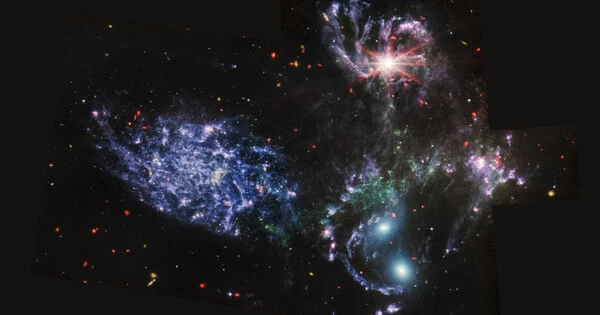Recent observations of cosmic microwave background radiation, the Big Bang’s afterglow, have revealed new details about the universe’s expansion over the last 13.8 billion years. These findings back up Albert Einstein’s general relativity theory, which has been the standard theory of gravity for over a century.
The collaboration’s research has resulted in a groundbreaking new image that reveals the most detailed map of dark matter distributed across a quarter of the entire sky, reaching deep into the cosmos. The findings add to Einstein’s theory of general relativity, which has been the foundation of the standard model of cosmology for more than a century, and offer new methods to debunk dark matter.
Humans have been fascinated by the mysteries of the cosmos for millennia.
Modern cosmologists, unlike ancient philosophers who imagined the universe’s origins, use quantitative tools to gain insights into the universe’s evolution and structure. Modern cosmology began with the development of Albert Einstein’s theory of general relativity in the early twentieth century.
The Atacama Cosmology Telescope (ACT) collaboration has now created a groundbreaking new image that reveals the most detailed map of dark matter distributed across a quarter of the entire sky, extending deep into the cosmos. Furthermore, it confirms Einstein’s theory of how massive structures grow and bend light over the universe’s entire 14-billion-year life span.
We have mapped the invisible dark matter across the sky to the greatest distances, and we can clearly see features of this invisible world that are hundreds of millions of light-years across.
Blake Sherwin
“We have mapped the invisible dark matter across the sky to the greatest distances, and we can clearly see features of this invisible world that are hundreds of millions of light-years across,” says Blake Sherwin, professor of cosmology at the University of Cambridge and leader of an ACT research group. “It appears to be exactly as our theories predicted.”
Dark matter has been difficult to detect despite accounting for 85% of the universe and influencing its evolution because it does not interact with light or other forms of electromagnetic radiation. Dark matter, as far as we know, only interacts with gravity.
To find it, the more than 160 collaborators who built and collected data from the National Science Foundation’s Atacama Cosmology Telescope in the high Chilean Andes look for light emitted after the Big Bang, when the universe was only 380,000 years old. This diffuse light that fills our entire universe is referred to by cosmologists as the “baby picture of the universe,” but it is formally known as the cosmic microwave background radiation (CMB).

New findings that map the universe’s cosmic growth support Einstein’s theory of gravity
The team studies how the gravitational pull of large, heavy structures, including dark matter, warps the CMB on its 14-billion-year journey to us, similar to how light bends as it passes through a magnifying glass’s lens.
“We created a new mass map using light distortions left over from the Big Bang,” says Mathew Madhavacheril, assistant professor in the University of Pennsylvania’s Department of Physics and Astronomy. “Remarkably, it provides measurements that show that the universe’s ‘lumpiness’ and rate of expansion after 14 billion years of evolution are exactly what you’d expect from our standard model of cosmology based on Einstein’s theory of gravity.”
Sherwin adds, “our results also provide new insights into an ongoing debate some have called ‘The Crisis in Cosmology,'”explaining that this crisis stems from recent measurements that use a different background light, one emitted from stars in galaxies rather than the CMB. These have produced results that suggest the dark matter was not lumpy enough under the standard model of cosmology and led to concerns that the model may be broken. However, the team’s latest results from ACT were able to precisely assess that the vast lumps seen in this image are the exact right size.
“When I first saw them, our measurements were in such good agreement with the underlying theory that it took me a moment to process the results,” says Cambridge Ph.D. student Frank Qu, part of the research team. “It will be interesting to see how this possible discrepancy between different measurements will be resolved.”
“The CMB lensing data rivals more conventional surveys of the visible light from galaxies in their ability to trace the sum of what is out there,” says Suzanne Staggs, director of ACT and Henry DeWolf Smyth Professor of Physics at Princeton University. “Together, the CMB lensing and the best optical surveys are clarifying the evolution of all the mass in the universe.”
“When we proposed this experiment in 2003, we had no idea the full extent of information that could be extracted from our telescope,” says Mark Devlin, the Reese Flower Professor of Astronomy at the University of Pennsylvania and the deputy director of ACT. “We owe this to theorists’ ingenuity, the many people who built new instruments to make our telescope more sensitive, and the new analysis techniques developed by our team.”
ACT, which had been in operation for 15 years, was decommissioned in September 2022. Nonetheless, more papers presenting results from the final set of observations are expected to be submitted soon, and the Simons Observatory will continue to conduct observations at the same location, with a new telescope set to begin operations in 2024. This new instrument will be capable of mapping the sky almost 10 times faster than ACT.





